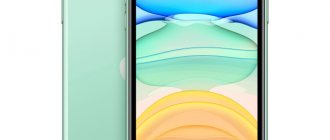Every phone's Camera app has a Zoom feature. But in most cases we are talking about digital zoom. That is, when the original resolution of the captured image does not change, but is simply scaled.
This leads to the fact that with high magnification the picture becomes unclear, the pixel size becomes larger, and sharpness is lost. And even with a 3x zoom, the final image can hardly be called high-quality. Even if we are talking about flagship smartphone models.
But phones with optical zoom perform this operation differently.
Their camera module has a multi-lens system. And when the user clicks “enlarge” in the application, the resolution remains the same. Instead, the lenses are slightly shifted, which allows you to get the effect of a “spyglass”.
Even when the 10x optical zoom is activated, the image still remains legible and clear. Which smartphone with optical zoom is considered the best?
Claimed optical magnification and actual
Quite often, the optical magnification indicated by the manufacturer does not correspond to real indicators. For example, you can take the Xiaomi Mi10 Note smartphone. The manufacturer claims that its camera module provides 5x optical zoom. Independent tests show that it is only x3.8.
What is this connected with? With the fact that the manufacturer indicates exactly the hybrid zoom level. That is, when both optical and digital enlargement of the image from the camera are combined at the same time. And the Xiaomi Mi 10 Ultra generally announced a 120x zoom. But the optical one is only x4.8.
Xiaomi Mi 10 Ultra smartphone camera
The user needs to understand that it is almost impossible to achieve optical zoom above x10 in smartphones. Because this characteristic directly proportionally affects the size of the camera module. And they try to make phones as thin and compact as possible.
That is, a module with 120x magnification would have to protrude from the body by about 4 - 5 centimeters. In conventional cameras, a moving lens is used for this purpose. It’s technically difficult to do this on phones.
OnePlus 8 Pro
Available in two versions, with 8 GB or 12 GB of RAM.
The user can choose which device he wants depending on how many applications will be running at the same time. The modern flagship chip from Qualcomm called Snapdragon 865 is used as the central processor in any version.
The display has a high refresh rate of 240 Hz. The finger scanner is located in the screen itself, so you don't have to reach for it. To take photos and videos, a module of three cameras equipped with different types of lenses is used.
The resolution of two of them is 48 MP. The front camera also has autofocus and its matrix resolution is 16 MP.
Pros:
- a large amount of RAM;
- nice branded shell;
- Responsive display with high response speed.
Minuses:
- the camera block protrudes too much;
- no headphone jack.
Huawei P40 Pro+
Smartphone with optical zoom Huawei P40 Pro+
This is a phone with a new generation of optical stabilization, which was achieved both through a special design of the camera module and through software (rumored to be developed jointly with Leica).
During video shooting, an optical zoom of x5 is available, and a hybrid zoom of up to x10. The camera module is triple, so there are no problems with focusing even with high magnification.
And the Kirin 990 CPU, which also received neural cores, is responsible for digital image processing. This means that over time, the smartphone “adjusts” to the shooting style used by the user. And this should theoretically improve the quality of the photos and videos taken.
Additional characteristics:
- 6.58 inch screen,
- RAM - 8 gigabytes,
- front camera - 32 megapixels (with digital zoom and stabilization),
- battery - 4200 mAh.
The quality of shooting is not inferior to the same Google Pixel 5. And at the time of release, it was the P40 Pro+, according to DxOMark, that was the smartphone with the most advanced camera in the world.
The only drawback of the model is the cost, and there are no Google services out of the box (you can install them yourself).
Top 5. OnePlus 9R 8GB/128GB
Rating (2021): 4.59
55 reviews from resources were taken into account: ROZETKA, Yandex.Market, Onliner, Ozon
Optimal price-quality ratio Inexpensive smartphone with OIS and good photographic capabilities. It costs less than flagships, and the photos are about the same in quality.
- Characteristics
Average price: 35150 rub.
- Country: China
- Main camera: 48 + 16 + 5 + 2 MP
- Camera features: f/1.7, 480 fps
- Front camera: 16 MP, without autofocus, f/2.4
- Battery: 4500 mAh
- Weight: 189 g
A chic pre-flagship smartphone with improved camera capabilities and an attractive price-quality ratio. You need to pay a little less than two times 20,000 rubles to purchase it, and for this money you get a 48-megapixel module with optical stabilization. The photos come out excellent by the standards of sub-flagships, and the video quality is also good. For example, the device is capable of shooting videos at a frame rate of as much as 480 per second. Users complain about the macro camera and believe that it would be better if the manufacturer did not install it at all. Reviews are also dissatisfied with the heating of the case under load and the short battery life. If you want to extend battery life, we recommend turning off the high-speed mode (it is at 120 Hz).
Advantages and disadvantages
- Great screen with 120Hz
- High frame rate when shooting video
- Weak macromodule
- Gets hot under load
- Battery life is short
Samsung Galaxy S21 Ultra
Smartphone with optical zoom Samsung Galaxy S21 Ultra
The main camera of the Samsung flagship has a resolution of 108 megapixels. And due to the telescopic structure of the module, it is equipped with 10x optical zoom.










